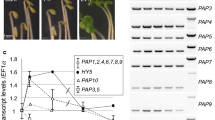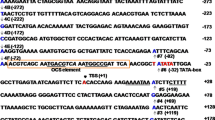Abstract
Promoter regions of the Nicotiana tabacum PHYA1 and PHYA2 genes display 89% sequence identity. Analysis of the 5′ ends of both the PHYA1 and the PHYA2 transcript revealed multiple, distinct mRNA species, each differing in length and in abundance. The levels of the major PHYA1, PHYA2 transcripts were found to be auto-regulated by phytochrome. This auto-regulation was most efficient in 2–8-day old seedlings. Furthermore, we examined the expression pattern of the PHYA1-GUS reporter gene, containing a 4700 bp PHYA1 promoter fragment or its 5′-deletion derivatives, by GUS histochemistry and by RNase protection assays in transgenic tobacco plants. Our data indicate that the PHYA1 promoter contains three regions which are necessary for the maximum level and regulated expression. We show that a 264 bp promoter fragment contains a cis-regulatory element(s) responsible for expression in the root tips of transgenic seedlings. The major cis-regulatory elements required for high-level transcription and expression in other organs are located in separate regions of the PHYA1 promoter. These data indicate the contribution of multiple cis-regulatory elements for the maximum and regulated expression of tobacco genes coding for phytochrome A protein.
Similar content being viewed by others
References
Kendrick RE, Kronenberg GHM: Photomorphogenesis in Plants. Martinus Nijhoff, Dordrecht (1986).
Quail PH: Phytochrome: a light-activated molecular switch that regulates plant gene expression. Annu Rev Genet 25: 389–409 (1991).
Furuya M: Phytochromes: their molecular species, gene families, and functions. Annu Rev Plant Physiol Plant Mol Biol 44: 617–645 (1993).
Sharrock RA, Quail PH: Novel phytochrome sequences in Arabidopsis thaliana: structure, evolution and differential expression of a plant regulatory photoreceptor family. Genes Devel 3: 1745–1757 (1989).
Clack T, Mathews S, Sharrock RA: The phytochrome apoprotein family in Arabidopsis is encoded by five genes: The sequences and expression of PHYD and PHYE. Plant Mol Biol 25: 413–427 (1994).
Reed WJ, Nagpal P, Poole DS, Furuya M, Chory J: Mutations in the gene for red/far-red light receptor phytochrome B alter cell elongation and physiological responses throughout Arabidopsis development. Plant Cell 5: 147–157 (1993).
Parks BM, Quail PH: hy8, a new class of Arabidopsis long hypocotyl mutants deficient in functional phytochrome A. Plant Cell 5: 39–48 (1993).
Neuhaus G, Bowler C, Kern R, Chua NH: Calcium/calmodulin-dependent and-independent phytochrome signal transduction pathways. Cell 73: 937–952 (1993).
Bowler C, Neuhaus G, Yamagata H, Chua NH: Cyclic GMP and calcium mediate phytochrome phototransduction. Cell 77: 73–81 (1994).
Nagy F, Kay SA, Chua NH: Gene regulation by phytochrome. Trends Genet 4: 37–41 (1988).
Bruce WB, Quail PH: Cis-acting elements involved in photoregulation of an oat phytochrome promoter in rice. Plant Cell 2: 1081–1089 (1990).
Bruce WB, Deng XW, Quail PH: A negatively acting DNA sequence element mediates phytochrome-directed repression of phyA gene transcription. EMBO J 10: 3015–3024 (1991).
Dehesh K, Bruce WB, Quail PH: Light-regulated expression of a trans-acting factor that binds a GT-motif in a phytochrome gene promoter. Science 250: 1397–1399 (1990).
Sato N: Nucleotide sequence and expression of the phytochrome gene in Pisum sativum: differential regulation by light of multiple transcripts. Plant Mol Biol 11: 697–710 (1988).
Tomizawa K, Sato N, Furuya M: Phytochrome control of multiple transcripts of the phytochrome gene in Pisum sativum. Plant Mol Biol 12: 295–299 (1989).
Dehesh K, Franci C, Sharrock RA, Somers DE, Welsch JA, Quail PH: The Arabidopsis phytochrome A gene has multiple transcription start sites and a promoter sequence motif homologous to the repressor element of monocot phytochrome A genes. Photochem Photobiol 59: 379–384 (1994).
Adam E, Deak M, Kay SA, Chua NH, Nagy F: Sequence of a tobacco (Nicotiana tabacum) gene coding for type A phytochrome. Plant Physiol 101: 1407–1408 (1993).
Adam E, Szell M, Szekeres M, Schafer E, Nagy F: The developmental and tissue-specific expression of tobacco phytochrome-A genes. Plant J 6: 283–293 (1994).
Fraley RT, Rogers SG, Horsch RB, Eicholtz DA, Flick JS, Fink CL, Hoffmann NL, Sanders PR: The SEV system: A new disarmed Ti plasmid vector system for plant transformation. Bio/technology 3: 629–635 (1985).
Nagy F, Kay SA, Chua NH: Analysis of gene expression in transgenic plants. In: Gelvin SB, Schilperoort RA (eds) Plant Molecular Biology Manual, pp. B4: 1–29. Kluwer Academic Publishers, Dordrecht, Netherlands (1988).
Jefferson RA: Assaying chimeric genes in plants: the GUS gene fusion system. Plant Mol Biol Rep 5: 387–405 (1987).
Sambrook J, Fritsch EF, Maniatis M: Molecular Cloning: A Laboratory Manual, 2nd ed. Cold Spring Harbor Laboratory Press, Cold Spring Harbor, NY (1989).
Green PJ, Kay SA, Chua NH: Sequence specific interaction of a pea nuclear factor with light responsive elements upstream of the rbcS-3A gene. EMBO J 6: 2543–2549 (1987).
Gilmartin PM, Memelink J, Hiratsuka K, Kay SA, Chua NH: Characterization of a gene encoding a DNA binding protein with specificity for a light-responsive element. Plant Cell 4: 839–849 (1992).
Perisic O, Lam E: A tobacco DNA binding protein that interacts with a light-responsive box-II element. Plant Cell 4: 831–838 (1992).
Benfey PN, Ren L, Chua NH: Combinatorial and synergistic properties of CaMV 35S enhancer subdomains. EMBO J 9: 1685–1696 (1988).
Benfey PN, Ren L, Chua NH: The CaMV enhancer contains at least two domains which can confer different developmental and tissue-specific expression patterns. EMBO J 8: 2195–2202 (1989).
Katagiri F, Lam E, Chua NH: Two tobacco DNA-binding proteins with homology to the nuclear factor CREB. Nature 340: 727–730 (1989).
Author information
Authors and Affiliations
Rights and permissions
About this article
Cite this article
Adam, E., Kozma-Bognar, L., Dallmann, G. et al. Transcription of tobacco phytochrome-A genes initiates at multiple start sites and requires multiple cis-acting regulatory elements. Plant Mol Biol 29, 983–993 (1995). https://doi.org/10.1007/BF00014971
Received:
Accepted:
Issue Date:
DOI: https://doi.org/10.1007/BF00014971




